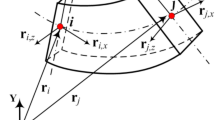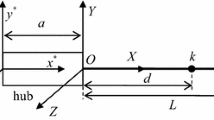Abstract
Dynamic analysis of flexible body under large rotation becomes increasingly important in many engineering applications. This work takes rotating flexible beam as numerical example under assumptions of straight beam, small deformation and fixed axis rotation. Results of six finite element methods are compared: floating frame of reference formulation (FFRF), generalized component mode synthesis (GCMS), total Lagrangian formulation (TLF), linear Euler–Bernoulli beam (LEBB), nonlinear Euler–Bernoulli beam (NEBB) and absolute nodal coordinate formulation (ANCF). Due to the effect of geometric nonlinearity or centrifugal stiffening, the results of linear methods FFRF, GCMS and LEBB are different to geometrically nonlinear methods TLF, NEBB and ANCF. Three points of view are obtained through numerical result analysis. Firstly, based on the equivalence between FFRF and GCMS, a special type of parametrically excited nonlinear system is equivalent to linear system, so as to analyze the Lyapunov stability of its solution. Secondly, for the ANCF, the system invariant matrix is presented to calculate elastic force, which avoids element integration or assembling in each time step, and then the computational efficiency is improved by at least an order of magnitude when compared to adopting element invariant matrix. Thirdly, for GCMS, TLF and ANCF, the velocity of relative coordinate for deformation is adopted to calculate linear internal damping force, which gets different deflection result in comparison with adopting velocity of absolute coordinate for deformation, under large rotational speed.











Similar content being viewed by others
Data availability
The presented methods are implemented in C++, and the results of numerical examples can be replicated on the basis of supplementary material.
References
Ziegler, P., Eberhard, P.: Simulative and experimental investigation of impacts on gear wheels. Comput. Methods Appl. Mech. Eng. 197, 4653–4662 (2008)
Zwölfer, A., Gerstmayr, J.: Preconditioning strategies for linear dependent generalized component modes in 3D flexible multibody dynamics. Multibody Syst. Dyn. 47, 65–93 (2019)
Thube, S.V., Bobak, T.R.: Dynamic Analysis of a Cycloidal Gearbox Using Finite Element Method. AGMA Technical Paper, Virginia (2012)
Hastings, G.G., Book, W.J.: A linear dynamic model for flexible robotic manipulators. IEEE Contr. Syst. Mag. 7, 61–64 (1987)
Yang, H., Hong, J., Yu, Z.: Dynamics modelling of a flexible hub-beam system with a tip mass. J. Sound Vib. 266, 759–774 (2003)
Bayoumy, A.H., Nada, A.A., Megahed, S.M.: A continuum based three-dimensional modeling of wind turbine blades. J. Comput. Nonlinear Dyn. 8, 031004 (2013)
Shabana, A.A.: Dynamics of Multibody Systems. Cambridge University Press, Cambridge (2005)
Belytschko, T., Liu, W.K., Moran, B., Elkhodary, K.I.: Nonlinear Finite Elements for Continua and Structures. Wiley, Chiechester (2014)
Likins, P.W.: Finite element appendage equations for hybrid coordinate dynamic analysis. Int. J. Solids Struct. 8, 709–731 (1972)
Pechstein, A., Reischl, D., Gerstmayr, J.: A generalized component mode synthesis approach for flexible multibody systems with a constant mass matrix. J. Comput. Nonlinear Dyn. 8, 011019 (2013)
Zwölfer, A., Gerstmayr, J.: The nodal-based floating frame of reference formulation with modal reduction. Acta. Mech. 232, 835–851 (2021)
Orzechowski, G., Matikainen, M.K., Mikkola, A.M.: Inertia forces and shape integrals in the floating frame of reference formulation. Nonlinear Dyn. 88, 1953–1968 (2017)
Huang, G., Zhu, W., Yang, Z., Feng, C., Chen, X.: Reanalysis-based fast solution algorithm for flexible multi-body system dynamic analysis with floating frame of reference formulation. Multibody Syst. Dyn. 49, 271–289 (2020)
Schilder, J., Dwarshuis, K., Ellenbroek, M., de Boer, A.: The tangent stiffness matrix for an absolute interface coordinates floating frame of reference formulation. Multibody Syst. Dyn. 47, 243–263 (2019)
Cammarata, A., Pappalardo, C.M.: On the use of component mode synthesis methods for the model reduction of flexible multibody systems within the floating frame of reference formulation. Mech. Syst. Signal Process. 142, 106745 (2020)
Shabana, A.A., Wang, G.: Durability analysis and implementation of the floating frame of reference formulation. Proc. Inst. Mech. Eng. Part K J. Multi-body Dyn. 232, 295–313 (2018)
Gerstmayr, J., Schöberl, J.: A 3D finite element method for flexible multibody systems. Multibdody Syst. Dyn. 15, 309–324 (2006)
Gerstmayr, J., Ambrósio, J.A.C.: Component mode synthesis with constant mass and stiffness matrices applied to flexible multibody systems. Int. J. Numer. Methods Eng. 73, 1518–1546 (2008)
Ziegler, P., Humer, A., Pechstein, A., Gerstmayr, J.: Generalized component mode synthesis for the spatial motion of flexible bodies with larger rotations about one axis. J. Comput. Nonlinear Dyn. 11, 041018 (2016)
Lin, T., Peng, Q., Liu, W., Chen, B.: Centrifugal stiffening analysis of gear pair with generalized component mode synthesis and semi-analytic contact technique. Meccanica 55, 567–579 (2020)
Zienkiewicz, O.C., Taylor, R.L.: The Finite Element Method. Elsevier Butterworth-Heinemann, Oxford (2005)
Kee, Y.J., Shin, S.J.: Structural dynamic modeling for rotating blades using three dimensional finite elements. J. Mech. Sci. Technol. 29, 1607–1618 (2015)
Kim, Y.S., Cho, J.R.: Numerical analysis of rollover and head-on crash response of non-step bus. Int. J. Mod. Phy. B 22, 1736–1741 (2008)
Tang, S.C., Pan, J.: Mechanics Modeling of Sheet Metal Forming. SAE International, Warrendale (2007)
Taylor, Z.A., Cheng, M., Ourselin, S.: High-speed nonlinear finite element analysis for surgical simulation using graphics processing units. IEEE Trans. Med. Imaging 27, 650–663 (2008)
Joldes, G.R., Wittek, A., Miller, K.: Real-time nonlinear finite element computations on GPU - Application to neurosurgical simulation. Comput. Methods Appl. Mech. Eng. 199, 3305–3314 (2010)
Laiarinandrasana, L., Piques, R., Robisson, A.: Visco-hyperelastic model with internal state variable coupled with discontinuous damage concept under total Lagrangian formulation. Int. J. Plasticity 19, 977–1000 (2003)
Siqueira, T.M., Coda, H.B.: Total Lagrangian FEM formulation for nonlinear dynamics of sliding connections in viscoelastic plane structures and mechanisms. Finite Elem. Anal. Des. 129, 63–77 (2017)
Castañar, I., Baiges, J., Codina, R.: A stabilized mixed finite element approximation for incompressible finite strain solid dynamics using a total Lagrangian formulation. Comput. Methods Appl. Mech. Eng. 368, 113164 (2020)
Tojaga, V., Hazar, S., Östlund, S.: Compressive failure of fiber composites containing stress concentration: homogenization with fiber-matrix interfacial decohesion based on a total Lagragian formulation. Compos. Sci. Technol. 182, 107758 (2019)
Zhang, X., Wang, T., Liu, Y.: Computational Dynamics. Tsinghua University Press, Beijing (2015)
Liu, Z., Liu, J.: Experimental validation of rigid-flexible coupling dynamic formulation for hub-beam system. Multibody Syst. Dyn. 40, 303–326 (2017)
Wang, G., Qi, Z., Xu, J.: A high-precision co-rotational formulation of 3D beam elements for dynamic analysis of flexible multibody systems. Comput. Methods Appl. Mech. Eng. 360, 112701 (2020)
Sun, Q.: An existence condition for the inverse dynamics solution of a slewing Euler-Bernoulli beam. Mech. Mach. Theory 46, 845–860 (2011)
Lu, J., Sun, X., Vakakis, A.F., Bergman, L.A.: Influence of backlash in gear reducer on dynamic of single-link manipulator arm. Robotica 33, 1671–1685 (2015)
Kim, K., Ri, K., Yun, C., Pak, C., Han, P.: Nonlinear forced vibration analysis of composite beam considering internal damping. Nonlinear Dyn. 107, 3407–3423 (2022)
Mayo, J., Dominguez, J., Shabana, A.A.: Geometrically nonlinear formulations of beams in flexible multibody dynamics. J. Vib. Acoust. 117, 501–509 (1995)
Liu, Z., Hong, J., Liu, J.: Finite element formulation for dynamics of planar flexible multi-beam system. Multibody Syst. Dyn. 22, 1–26 (2009)
Zhao, G., Wu, Z.: Coupling vibration analysis of rotating three-dimensional cantilever beam. Comput. Struct. 179, 64–74 (2017)
Torteman, B., Kessler, Y., Liberzon, A., Krylov, S.: Micro-beam resonator parametrically excited by electro-thermal Joule’s heating and its use as a flow sensor. Nonlinear Dyn. 98, 3051–3065 (2019)
Wang, L., Peng, J., Zhang, X., Qiao, W., He, K.: Nonlinear resonant response of the cable-stayed beam with one-to-one internal resonance in veering and crossover regions. Nonlinear Dyn. 103, 115–135 (2021)
Shabana, A.A., Yakoub, R.Y.: Three dimensional absolute nodal coordinate formulation for beam elements: Theory. J. Mech. Des. 123, 606–613 (2001)
Yakoub, R.Y., Shabana, A.A.: Three dimensional absolute nodal coordinate formulation for beam elements: implementation and applications. J. Mech. Des. 123, 614–621 (2001)
Gerstmayr, J., Matikainen, M.K., Mikkola, A.M.: A geometrically exact beam element based on the absolute nodal coordinate formulation. Multibody Syst. Dyn. 20, 359–384 (2008)
Obrezkov, L.P., Mikkola, A., Matikainen, M.K.: Performance review of locking alleviation methods for continuum ANCF beam elements. Nonlinear Dyn. 109, 531–546 (2022)
Patel, M., Shabana, A.A.: Locking alleviation in the large displacement analysis of beam elements: the strain split method. Acta. Mech. 229, 2923–2946 (2018)
Shen, Z., Li, P., Liu, C.: A finite element beam model including cross-section distortion in the absolute nodal coordinate formulation. Nonlinear Dyn. 77, 1019–1033 (2014)
Vallejo, D.G., Mikkola, A.M., Escalona, J.L.: A new locking-free shear deformable finite element based on absolute nodal coordinates. Nonlinear Dyn. 50, 249–264 (2007)
Vallejo, D.G., Mayo, J., Escalona, J.L., Domínguez, J.: Efficient evaluation of the elastic forces and the Jocobian in the absolute nodal coordinate formulation. Nonlinear Dyn. 35, 313–329 (2004)
Dibold, M., Gerstmayr, J., Irschik, H.: A detailed comparison of the absolute nodal coordinate and the floating frame of reference formulation in deformable multibody systems. J. Comput. Nonlinear Dyn. 4, 021006 (2009)
Vallejo, D.G., Valverde, J., Domínguez, J.: An internal damping model for the absolute nodal coordinate formulation. Nonlinear Dyn. 42, 347–369 (2005)
Inman, D.J.: Engineering Vibration. Pearson, Essex (2014)
Greenwood, D.T.: Advanced Dynamics. Cambridge University Press, Cambridge (2003)
Wriggers, P.: Computational Contact Mechanics. Springer, Berlin (2006)
Wang, X.: Finite Element Method. Tsinghua University Press, Beijing (2003)
Mahdiabadi, M.K., Tiso, P., Brandt, A., Rixen, D.J.: A non-intrusive model-order reduction of geometrically nonlinear structural dynamics using modal derivatives. Mech. Syst. Signal Process. 147, 107126 (2021)
Lee, J.W., Kim, H.W., Ku, H.C., Yoo, W.S.: Comparison of external damping models in a large deformation problem. J. Sound Vib. 325, 722–741 (2009)
Sauer, T.: Numerical Analysis. Pearson, Boston (2012)
LSTC: LS-DYNA Theory Manual. LSTC, Livermore (2014)
Rao, S.S.: Mechanical Vibrations. Pearson, Harlow (2018)
Nayfeh, A.H., Mook, D.T.: Nonlinear Oscillations. Wiley, Weinheim (2004)
Zhang, J.: A direct Jacobian total Lagrangian explicit dynamics finite element algorithm for real-time simulation of hyperelastic materials. Int. J. Numer. Methods Eng. 122, 5744–5772 (2021)
Li, P., Liu, C., Tian, Q., Hu, H., Song, Y.: Dynamics of a deployable mesh reflector of satellite antenna: parallel computation and deployment simulation. J. Comput. Nonlinear Dyn. 11, 061005 (2016)
Liu, J., Pan, K.: Rigid-flexible-thermal coupling dynamic formulation for satellite and plate multibody system. Aerosp. Sci. Technol. 52, 102–114 (2016)
Acknowledgements
The authors gratefully acknowledge the open-source library Eigen (http://eigen.tuxfamily.org/index.php?title=Main_Page) from eigenproject team and the open source library Spectra (http://spectralib.org/index.html) from Yixuan Qiu.
Author information
Authors and Affiliations
Contributions
All authors contributed to the study conception and design. The first draft of the manuscript was written by Quancheng Peng, and all authors commented on previous versions of the manuscript. All authors read and approved the final manuscript.
Corresponding author
Ethics declarations
Conflict of interest
The authors declare that they have no conflict of interest.
Additional information
Publisher's Note
Springer Nature remains neutral with regard to jurisdictional claims in published maps and institutional affiliations.
Supplementary Information
Below is the link to the electronic supplementary material.
Appendix
Appendix
where \(q_{ei}\) is the i-th component of vector \(\varvec{q}_e\).
where \(W_{\mathrm{{f}}ei}\) is the i-th component of vector \(\varvec{W}_{\mathrm{{f}}e}\), \({\varvec{H}_{\mathrm{{f}}ei}} = \frac{{\partial {\varvec{W}_{\mathrm{{f}}e}}}}{{\partial {W_{\mathrm{{f}}ei}}}}\).
where \(q_{\mathrm{{r}}i}\) is the i-th component of vector \(\varvec{q}_\mathrm{{r}}\).
Rights and permissions
Springer Nature or its licensor (e.g. a society or other partner) holds exclusive rights to this article under a publishing agreement with the author(s) or other rightsholder(s); author self-archiving of the accepted manuscript version of this article is solely governed by the terms of such publishing agreement and applicable law.
About this article
Cite this article
Peng, Q., Li, M. Comparison of finite element methods for dynamic analysis about rotating flexible beam. Nonlinear Dyn 111, 13753–13779 (2023). https://doi.org/10.1007/s11071-023-08568-7
Received:
Accepted:
Published:
Issue Date:
DOI: https://doi.org/10.1007/s11071-023-08568-7




